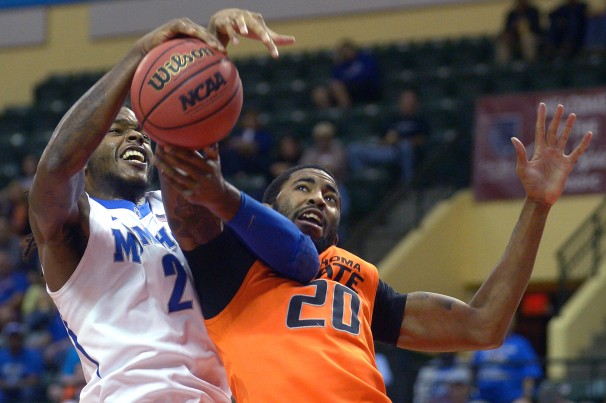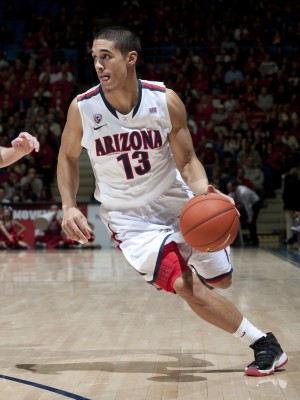Otskey’s Observations: Episode IV
Posted by Brian Otskey (@botskey) on December 4th, 2013Over the last 10 days I have been lucky enough to see multiple national contenders in person, specifically Arizona, Duke, Michigan State and Kentucky. Of those four teams, Arizona impressed me the most. While T.J. McConnell certainly adds another dimension to Sean Miller’s offense as a true point guard (something they sorely missed last year), the most convincing part of the Wildcats’ performance against Duke was their defense. That is the kind of effort that will enable Arizona to get to the point where it is playing championship-level basketball. Arizona still needs to find a consistent shooter (Nick Johnson or Gabe York could be that guy), but I really like its potential. As for Duke, I am actually optimistic that it will turn its defensive problems around (the Michigan win was a great start in that regard), but I am not sure the Blue Devils can get to the level needed to win a national championship. I really liked what I saw out of Michigan State when I saw it play against Oklahoma. Keith Appling led the way for the Spartans and I just love the blend of talent and experience on this roster. Branden Dawson and Denzel Valentine seemed primed to take another step forward while Tom Izzo has three All-America candidates in Appling, Gary Harris and Adreian Payne leading the team in scoring. One area of concern for Michigan State is its offensive rebounding, which has been uncharacteristically poor in the early-going. It’s something to keep an eye on, but remember, Izzo’s teams always get better as the season goes along. This one shouldn’t be any different. Of the four teams, Kentucky has the most room for growth. What I saw from Willie Cauley-Stein on Sunday night against Providence was something that makes the Wildcats very scary going forward. UK has NBA length up front and the talent to dominate inside the arc on both ends of the floor. Kentucky’s defense is not at an elite level just yet but this game provided us with a glimpse of what it can be. Mid- to long-range jump shooting is not a strength of this team but as long as it controls the paint and limits turnovers, John Calipari will have even more options to turn to.
After taking the Battle 4 Atlantis title, Villanova rightly earned a spot in this week’s Top 25. The Wildcats have been the most impressive team in the Big East to date, a conference that has struggled as a whole out of the gate. While I did slot the Wildcats in my rankings at No. 19, I’m not ready to fully buy in just yet. I love this team’s toughness and chemistry from what I saw in Atlantis but there are some clear limitations that I have noticed, even in its wins. The turnover problems that plagued this team all of last season are still there, albeit not to the same degree. Turnovers absolutely kill offensive efficiency and Villanova simply cannot afford it on a continuing basis against better teams. Another red flag is their three-point shooting, currently at 31.4 percent. For a team that relies heavily on triples (44.7 percent of field goals attempted), that can lead to a lot of hit-or-miss games. The old saying of living and dying by the three certainly applies to Villanova, which was on the good side of that equation in Atlantis. I would like to see JayVaughn Pinkston become a better presence on the low blocks, something that would immediately open up Villanova’s offense and make it more versatile. Jay Wright’s squad is clearly a team where the whole is greater than the sum of its parts, but it’s not like it lacks talent. The Wildcats have put themselves on the map but I need to see more of this team before I jump on board. A stern non-conference test at Syracuse (how weird is that to say regarding these old Big East rivals?) will give the Wildcats a great test. From the looks of it, it’ll be bombs away from three-point land.
Speaking of Syracuse, how awesome is it to see Trevor Cooney grow as a player and fill a major role on this team? The redshirt sophomore from Delaware has been lighting it up for Jim Boeheim’s team, averaging 14.3 PPG on 45.7 percent shooting from beyond the arc through eight games. With the departures of Brandon Triche, Michael Carter-Williams and James Southerland, huge amounts of playing time have opened up and Cooney has stepped right in almost seamlessly. While some observers are shocked, I contend that they should not be. As a former four-star recruit, Cooney is no slouch. He used his redshirt year to gain strength and experience in Boeheim’s system and got a taste of what it is like to play for a big-time program in his 11 minutes per game last year on a Final Four team. The 6’4” guard has also been a solid defender at the top of the zone for Boeheim, averaging 2.4 steals per game and ranking in the top 35 in steal percentage (along with freshman Tyler Ennis). The development and immediate dividends provided by Cooney speaks volumes about Boeheim’s player development program and his coaching staff. Dan Dakich said it on the broadcast last night and it’s true: For what he accomplishes in player development and program consistency, there may not be a more under-appreciated figure in college basketball than Boeheim.
Let’s have a round of applause for Memphis’ Josh Pastner, who finally got the Top 25 monkey off his back. The most impressive part about this win was the circumstances behind it. After being thoroughly embarrassed by Marcus Smart and Oklahoma State in Stillwater just 12 days earlier, the Tigers took down those same Cowboys on a neutral floor in Orlando by holding Smart and Markel Brown in check. Oklahoma State shot just 3-of-13 from deep, including Smart’s 0-of-5 mark. Memphis didn’t fare much better from beyond the arc but it showed toughness on the offensive glass and limited its turnovers. Shaq Goodwin and Chris Crawford had great games for Pastner’s team but it was a very balanced performance by the entire roster. In particular, Michael Dixon had a much better game the second time around against the Cowboys. Memphis still has a lot to prove but getting over that hump is incredibly significant from a psychological perspective. With a softer non-conference schedule still to play aside from a game against Florida in New York in two weeks time, the Tigers have a great opportunity to pad their record and build some more confidence and chemistry. If Memphis can knock off the Gators at Madison Square Garden, it will be another huge boost to a program that will need to be one of the standard-bearers for the American after Louisville departs for the ACC next summer.

Memphis’ victory over Oklahoma State was its first over a top 25 team in the Josh Pastner era. (Phelan M. Ebenhack/AP)
One team that had a great Feast Week that nobody seems to be talking about is Dayton. The Flyers took care of Gonzaga and California in impressive fashion at the Maui Invitational with their only loss coming by a single point to Baylor in the semifinals. Archie Miller’s team is relatively undersized but I like the makeup of this unit a lot. Jordan Sibert has enjoyed a terrific breakout season to date while Devin Oliver impressed in Maui and has turned into a solid four-year program player. Georgetown transfer Vee Sanford has added depth and experience to Miller’s rotation as well. Oliver in particular has put up terrific all-around numbers but I really like how he and his teammates get after it defensively. Dayton’s defense has forced plenty of turnovers and turned them into points on the other end. In their win over Georgia Tech before they went to Maui, the Flyers forced 19 Yellow Jacket turnovers and turned them into 33 points. Dayton has a chance to contend in an Atlantic 10 that is strong at the top but lacks great depth. Of its four games with the other contenders (VCU, Massachusetts, and St. Louis twice), only one comes on the road. With all three of those teams coming to Dayton Arena this winter, the Flyers won’t be short on chances to finish near or at the top of the league.
While instant replay reviews have been a net positive for college basketball, I have become increasingly frustrated with two things. First, the time it takes to conduct reviews when clear replays are freely available at most games, and second, the frequency with which such reviews are used. To me, it seems officials are increasingly using the replay monitor as a crutch to bail them out of certain situations. While it’s important to get calls right, officials at this level should not have to use the monitor as frequently as they do. Officiating, more than anything else, is about being in the right position to see the play. When officials are not in the right position, they miss fouls, out-of-bounds calls, flying elbows, you name it. The bottom line is to get in better position so you don’t have to be bailed out by the TV cameras and disrupt the flow of the game. As to my other concern, why does it take so long to determine what happened? Multiple angle replays are more than enough to determine what happened but some officials will stand at the monitor for minutes at a time and then get together as a group to talk about it. This hurts the game and is counter-productive. Another beef I have with replays rules is why certain things are only reviewable in the final two minutes of a game, such as shot clock violations. A great example came last night in the Duke/Michigan game where the officials missed a blatant Duke shot clock violation but were unable to review it because of the existing rules. Imagine if Duke had won the game by only two points. Just because something happens early in the game doesn’t mean it’s not as significant as something that occurs in the final minutes. Every point and every second counts in a 40-minute game.












































